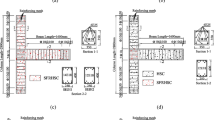Abstract
The ductility of external beam-column joints effects seismic behavior of a structure and can be a reason for structural collapse. High strength concrete and large amount of steel present in the joint region reduces the ductility even further. This study presents a radical way of increasing high strength concrete external beam-column joint’s ductility by varying the beam top reinforcement detailing. Two types of joints (three specimens each) were tested, type-1 specimens were prepared as per regular standards while type-2 specimens were prepared by reducing the beam’s top reinforcement anchoring in the column. Load-deflection behavior was studied to observe the stiffness degradation and energy dissipation by joints. Experimental results demonstrated that type-2 specimens were considerably more ductile as compared to type-1 specimens. The energy dissipated by type-2 joints (with 40% less reinforcing bar area in the beam) was 41.5% more than type-1 joints without substantial stiffness degradation. Furthermore, it was observed that by reducing the steel reinforcement in beam, the cracks location changed from inside the joint to beam-column joint’s face which may be attributed for increased ductility in type-2 joints. This study shows that by changing the steel reinforcement detailing near external beam-column joints, fatigue behavior and energy absorption capacity can be enhanced hence providing better performance against seismic activities.
Similar content being viewed by others
References
ACI Committee 352 (2002). Recommendations for design of beamcolumn connections in monolith reinforced concrete structures, ACI 352–02, American Concrete Institute, Farmington Hills, MI, USA.
ACI Committee 318 (2008). Building code requirements for structural concrete, ACI 318R-08, American Concrete Institute, Farmington Hills, MI, USA.
Alath, S. and Kunnath. S. K. (1995). Modeling inelastic shear deformation in RC beam-column joints engineering mechanics, MSc Thesis University of Colorado at Boulder, Boulder, CO, USA, pp. 21–24.
Baig, U. and Nagai, K. (2013). “Effect of self-compacting concrete and aggregate size on anchorage performance at highly congested reinforcement regions.” International Journal of Civil, Environmental, Structural, Construction and Architectural Engineering, Vol. 7, No. 9, pp. 670–678, DOI: 10.5281/zenodo.1087840.
Bakir, P. G. and Boduroglu, H. M. (2002). “A new design equation for predicting the joint shear strength of monotonically loaded exterior beam-column joints.” Engineering Structures, Vol. 24, pp. 1105–1117, DOI: 10.1016/S0141-0296(02)00038-X.
Clyde, C., Pantelides, C. P., and Reaveley, L. D. (2000). “Performancebased evaluation of exterior reinforced concrete building joints for seismic excitation.” Pacific Earthquake Engineering Research Report, PEER 2000/05. Berkeley: University of California.
Durrani, A. J. and Wight, J. K. (1985). “Behavior of interior beam-tocolumn connections under earthquake-type loading.” ACI Structural Journal, ACI, Vol. 82, No. 3, pp. 343–350, DOI: 10.14359/10341.
El-Metwally, S. E. and Chen, W. F. (1988). “Moment-rotation modeling of reinforced concrete beam-column connections.” ACI Structural Journal, ACI, Vol. 84, No. 5, pp. 384–394, DOI: 10.14359/2656.
Fattah, B. A. and Wight, J. K. (1987). “Study of moving beam plastic hinging zones for earthquake-resistant design of R/C buildings.” ACI Structural Journal, ACI, Vol. 84, No. 1, pp. 31–39, DOI: 10.14359/2767.
Jiuru, T., Chaobin, H., Kaijian, Y., and Yongcheng, Y. (1992). “No seismic behavior and shear strength of framed joint using steel-fiber reinforced concretetitle.” Journal of Structural Engineering, Vol. 118, No. 2, pp. 341–358, DOI: 10.1061/(ASCE)0733-9445(1992)118:2(341).
Kim, J. and LaFave, J. M. (2007). “Key influence parameters for the joint shear behavior of reinforced concrete beam-column connections.” Engineering Structures, Vol. 29, No. 10, pp. 2523–2539, DOI: 10.1016/j.engstruct.2006.12.012.
Lee, J. Y., Kim, J. Y., and Oh, G. J. (2009). “Strength deterioration of reinforced concrete beam-column joints subjected to cyclic loading.” Engineering Structures, Vol. 31, No. 9, pp. 2070–2085, DOI: 10.1016/j.engstruct.2009.03.009.
Leon, R. T. (1990). “Shear strength and hysteretic behavior of interior beam-column joints.” ACI Structural Journal, ACI, Vol. 87, No. 1, pp. 3–11, DOI: 10.14359/3198.
Lowes, L. N. and Moehle, J. P. (1999). “Evaluation and retrofit of beamcolumn T-Joints in older reinforced concrete bridge structures.” ACI Structural Journal, ACI, Vol. 96, No. 4, pp. 519–532, DOI: 10.14359/51710834.
Mazzoni, S. and Moehle, J. P. (2001). “Seismic response of beamcolumn joints in Double-Deck reinforced concrete bridge frames.” ACI Structural Journal, ACI, Vol. 98, No. 3, pp. 259–269, DOI: 10.14359/10215.
Metelli, G., Messali, F., Beschi, C., and Riva, P. (2015). “A model for beam–column corner joints of existing RC frame subjected to cyclic loading.” Engineering Structures, Vol. 89, pp. 79–92, DOI: 10.1016/J.ENGSTRUCT.2015.01.038.
Mitra, N. and Lowes, L. N. (2007). “Evaluation, calibration, and verification of a reinforced concrete beam-column joint model.” Journal of Structural Engineering, ASCE, Vol. 133, No. 1, pp. 105–120, DOI: 10.1016/j.engstruct.2015.01.038.
Park, R. and Ruitong, D. (1988). “A comparison of the behavior of reinforced concrete beam-column joints designed for ductility and limited ductility.” Bulletin of the New Zealand National Society of Earthquake Engineering, Vol. 21, No. 4, pp. 255–278.
Sharma, A., Eligehausen, R., and Reddy, G. R. (2011). “A New model to simulate joint shear behavior of poorly detailed beam–column connections in RC structures under seismic loads, Part I: Exterior joints.” Engineering Structures, Vol. 33, No. 3, pp. 1034–1051, DOI:10.1016/J.ENGSTRUCT.2010.12.026.
Tsonos, A. G., Tegos, I. A., and Penelis, G. Gr. (1992). “Seismic resistance of type 2 exterior beam-column joints reinforced with inclined bars.” ACI Structural Journal, ACI, Vol. 89, No. 1, pp. 3–12, DOI: 10.14359/1278.
Walker, S. G. (2001). Seismic performance of existing reinforce concrete beam-column joints, PhD Thesis, University of Washington, Seattle, WA, USA.
Yoshitake, K., Orgura, H., and Ogawa, A. (2010). “The effect of vertical and horizontal position of reinforcement for bond condition in beamcolumn joint.” Proc. 65th JSCE Annual Conference, JSCE, Hokkaido, Japan, pp. 1109–1110.
Author information
Authors and Affiliations
Corresponding author
Rights and permissions
About this article
Cite this article
Ahmed, A., Saleem, M.M. & Siddiqui, Z.A. Effect of Varying Top Beam Reinforcement Anchorage Details on Ductility of HSC Beam-Column Joints. KSCE J Civ Eng 23, 2272–2280 (2019). https://doi.org/10.1007/s12205-019-1285-6
Received:
Revised:
Accepted:
Published:
Issue Date:
DOI: https://doi.org/10.1007/s12205-019-1285-6




